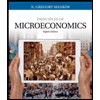[Adverse Selection] Each of the two players receives an envelope, in which there is an amount of money that is equally distributed from $0, $1, $2, ..., $100. The amounts in two envelopes are independent. After receiving the envelope, each individual can check exactly how much money is put in his/her own envelope. Then each player has the option to exchange his/her envelope for the other individual's prize. The decisions are made simultaneously. If both individuals agree to exchange, then the envelopes are exchanged; otherwise, if at least one player chooses not to exchange, each individual keeps his/her own envelope and receives its attached sum of money. a. Model this game as a static Bayesian game (write the normal form representation) and find the Bayesian Nash equilibrium. b. Consider a new game where the probability distribution of money in each envelope is changed. The amount is equal to $100 with probability 90%, and is equal to each number in $0, $1, $2, ... ,$99 with probability 0.1%. What is the optimal strategy in the Bayesian Nash equilibrium?
[Adverse Selection] Each of the two players receives an envelope, in which there is an amount of money that is equally distributed from $0, $1, $2, ..., $100. The amounts in two envelopes are independent. After receiving the envelope, each individual can check exactly how much money is put in his/her own envelope. Then each player has the option to exchange his/her envelope for the other individual's prize. The decisions are made simultaneously. If both individuals agree to exchange, then the envelopes are exchanged; otherwise, if at least one player chooses not to exchange, each individual keeps his/her own envelope and receives its attached sum of money. a. Model this game as a static Bayesian game (write the normal form representation) and find the Bayesian Nash equilibrium. b. Consider a new game where the probability distribution of money in each envelope is changed. The amount is equal to $100 with probability 90%, and is equal to each number in $0, $1, $2, ... ,$99 with probability 0.1%. What is the optimal strategy in the Bayesian Nash equilibrium?
Chapter7: Uncertainty
Section: Chapter Questions
Problem 7.3P
Related questions
Question
[Adverse Selection] Each of the two players receives an envelope, in which there is an
amount of money that is equally distributed from $0, $1, $2, ..., $100. The amounts in two
envelopes are independent. After receiving the envelope, each individual can check exactly
how much money is put in his/her own envelope. Then each player has the option to exchange
his/her envelope for the other individual's prize. The decisions are made simultaneously. If
both individuals agree to exchange, then the envelopes are exchanged; otherwise, if at least
one player chooses not to exchange, each individual keeps his/her own envelope and receives
its attached sum of money.
a. Model this game as a static Bayesian game (write the normal form
representation) and find the Bayesian Nash equilibrium.
b. Consider a new game where the probability distribution of money in each
envelope is changed. The amount is equal to $100 with probability 90%, and is equal
to each number in $0, $1, $2, ... ,$99 with probability 0.1%. What is the optimal strategy in the Bayesian Nash equilibrium?
amount of money that is equally distributed from $0, $1, $2, ..., $100. The amounts in two
envelopes are independent. After receiving the envelope, each individual can check exactly
how much money is put in his/her own envelope. Then each player has the option to exchange
his/her envelope for the other individual's prize. The decisions are made simultaneously. If
both individuals agree to exchange, then the envelopes are exchanged; otherwise, if at least
one player chooses not to exchange, each individual keeps his/her own envelope and receives
its attached sum of money.
a. Model this game as a static Bayesian game (write the normal form
representation) and find the Bayesian Nash equilibrium.
b. Consider a new game where the probability distribution of money in each
envelope is changed. The amount is equal to $100 with probability 90%, and is equal
to each number in $0, $1, $2, ... ,$99 with probability 0.1%. What is the optimal strategy in the Bayesian Nash equilibrium?
Expert Solution
This question has been solved!
Explore an expertly crafted, step-by-step solution for a thorough understanding of key concepts.
This is a popular solution!
Trending now
This is a popular solution!
Step by step
Solved in 4 steps with 1 images

Knowledge Booster
Learn more about
Need a deep-dive on the concept behind this application? Look no further. Learn more about this topic, economics and related others by exploring similar questions and additional content below.Recommended textbooks for you


Managerial Economics: A Problem Solving Approach
Economics
ISBN:
9781337106665
Author:
Luke M. Froeb, Brian T. McCann, Michael R. Ward, Mike Shor
Publisher:
Cengage Learning

Managerial Economics: Applications, Strategies an…
Economics
ISBN:
9781305506381
Author:
James R. McGuigan, R. Charles Moyer, Frederick H.deB. Harris
Publisher:
Cengage Learning


Managerial Economics: A Problem Solving Approach
Economics
ISBN:
9781337106665
Author:
Luke M. Froeb, Brian T. McCann, Michael R. Ward, Mike Shor
Publisher:
Cengage Learning

Managerial Economics: Applications, Strategies an…
Economics
ISBN:
9781305506381
Author:
James R. McGuigan, R. Charles Moyer, Frederick H.deB. Harris
Publisher:
Cengage Learning

Principles of Microeconomics
Economics
ISBN:
9781305156050
Author:
N. Gregory Mankiw
Publisher:
Cengage Learning

Principles of Economics (MindTap Course List)
Economics
ISBN:
9781305585126
Author:
N. Gregory Mankiw
Publisher:
Cengage Learning

Principles of Microeconomics (MindTap Course List)
Economics
ISBN:
9781305971493
Author:
N. Gregory Mankiw
Publisher:
Cengage Learning